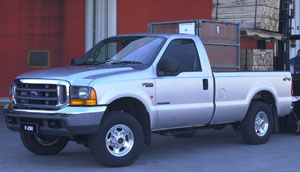Ford workhorse makes a comeback
BY TERRY MARTIN | 23rd Jul 2001

On sale from August 1, the Brazilian-built range will comprise the high and mighty F250 and F350 "super duty" trucks priced from $52,400 and corralled in a variety of cab, engine, tray, transmission and specification levels.
Representing a $30 million project that involved 18 months and more than 500,000km of local development work, the 4x2 and 4x4 behemoths are aimed squarely at rivals such as the Toyota LandCruiser and Nissan Patrol, and will cater for a huge number of semi-urban and rural applications in small and large businesses alike.
And they will be irresistible to self-indulgent suburbanites.
In every aspect of the vehicles - physical dimensions, gross vehicle mass, payload, towing capacity, engine performance, egotism - size matters.
Big-displacement diesel and petrol engines are found in each series with the volume-selling F250 line-up offering the full gamut: a 4.2-litre, six-cylinder turbo-diesel that produces 132kW at 3400rpm and 500Nm at 1600rpm a 7.3-litre, intercooled turbo-diesel V8 that musters 175kW at 2600rpm and a massive 684Nm at 1800rpm and a 5.4-litre V8 petrol engine good for 194kW at 4500rpm and 475Nm at 2500rpm.
The F350 will delete the 4.2-litre diesel and there are anomalies in both series regarding choice of transmission (auto or manual, 4x2 or 4x4), body style (pickup or cab-chassis) and specification level (XL or XLT).
All models are to be backed by Ford Australia's new-vehicle warranty and fitted with air-conditioning, power steering, power mirrors, AM/FM radio/cassette, a four-tonne hydraulic jack, 16-inch wheels and a limited slip differential.
The XLT adds dual airbags, front bucket seats, power windows, cruise control, remote locking, alloy wheels and, in most cases, four-wheel anti-lock brakes.
A staggered launch will introduce single-cab variants ahead of crew-cab (four doors and a rear bench seat) and super-cab (rear opposed doors and a folding rear seat) configurations, which are expected in forthcoming months.
Though Ford has introduced holding centres to speed up deliveries of popular variants, most customers will be required to wait six months after placing an order.
When in full swing, Ford anticipates sales of 2500-3000 vehicles per annum.
F-SERIES SINGLE CAB PRICING* F250 4x2 XL chassis/cab 5.4 petrol manual $52,400 XL chassis/cab 4.2 diesel manual $52,400 XLT pickup 5.4 auto $57,700 XLT chassis/cab 7.3 diesel auto $65,400 F250 4x4 XL chassis/cab 4.2 diesel manual $55,400 XLT pickup 7.3 diesel manual $67,300 XLT pickup 7.3 diesel auto $69,600 F350 4x2 XL chassis/cab 5.4 petrol manual $55,500 XL chassis/cab 7.3 diesel manual $68,900 XLT chassis/cab 7.3 diesel auto $74,100 * Crew cab and super cab pricing will be available in August, adding about $5000 and $7000 respectively onto the RRP.
DRIVE IMPRESSIONS: SO this is what it's like to be an American truck junkie. Perched on a throne, surrounded by acres of sheetmetal and soothed by the tones - er, loud groans - of a big diesel engine throbbing under the hood.
While admiring glances from would-be owners are reassuring, there are few comforts to be found within the cab of an F250 single or crew cab other than excellent front and rear visibility (the latter dependant on the tray configuration) and, in XLT trim, a snug fit in the front bucket seats and handy steering-wheel mounted cruise controls.
The interior is utilitarian and functional, with storage catered for to some extent by a series of bins in each front door and two big cup holders. There is no glovebox to speak of, though space to stuff coats et al. is provided behind the seats in the single cab.
There's enough room for two burly and one skinny bloke across the front (XL) or rear bench seat (dual cab), though the cabs do not cater for child seats and all centre positions use an insufficient lap belt - not good enough, commercial vehicle classification or not.
As to be expected, the 7.3-litre turbo-diesel V8 has a plethora of pulling power to conquer mountainous off-road terrain and the most difficult of towing applications. It comes into its own as a highwayman and makes a good team with the four-speed auto, which in most cases is a better proposition than the five-speed manual.
Unless big loads are to be carried, the 4.2-litre diesel will be sufficient for most owners. Surprisingly, it shows an appreciation for revs and it remains smooth and energetic as the tacho needle passes 3000rpm. It also has more than enough low-down grunt for any around-town or slow-speed off-road (4x4) application.
Taken in context, vehicle dynamics are largely benign and ride comfort is excellent across all surfaces, the quad-shock rear end - the most significant mechanical change made for Australian conditions - maintaining good control across dirt-road corrugations and the like.
For our money, the extra traction on loose dirt roads provided with 4x4 high-range makes it a worthwhile option - as is the four-wheel ABS system that comes on XLT models.
More serious off-road work is handled with aplomb by the 4x4s, the shift in and out of high and low range at once simple and temperamental - but proving its worth when the going gets tough.